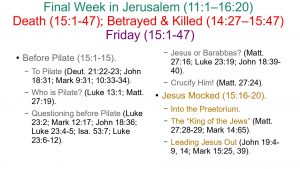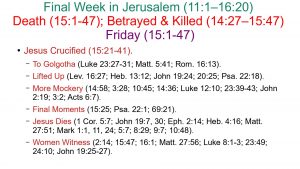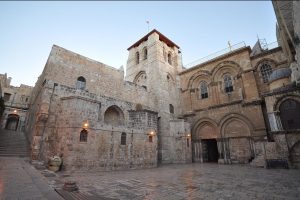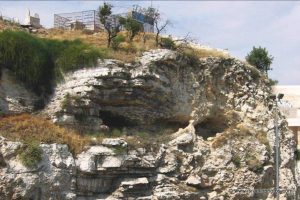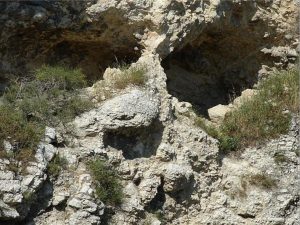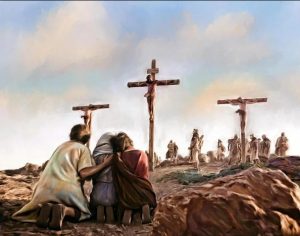Jesus’ Final Week in Jerusalem
Mark 11:1–16:20
Teaching (11:1–13:37)
King (11:1-11)
Sunday: Triumphal Entry (11:1-11).
Lawgiver (11:12–12:44)
Monday (11:12-19).
Tuesday (11:20–14:2).
Prophet (13:1-37)
Trial (14:1-72)
Sacrifice (14:1-26)
Wednesday (14:3-11).
Thursday (14:12-72)
Betrayed and Killed (14:27–15:47)
Death (15:1-47)
Friday (15:1-47).
Before Pilate (15:1-15).
Jesus Mocked (15:16-20).
The “King of the Jews.”
Leading Jesus out.
Before the soldiers remove the purple cloth, John records a few more things that happened (John 19:4-9).
I want to mention a couple of those things because they will play into what happens later, particularly in 15:39.
Pilate parades the beaten and bloodied Jesus in front of the people, reminding them that he finds no fault in Him. He says, “Behold the Man!”
The chief priests and officers continued to cry out, “Crucify Him!”
Pilate basically says he doesn’t want to, that they should do it instead.
Then we see the key phrase I want to focus on, that the Jews informed Pilate and the officers around him that, “He made Himself the Son of God.”
What was Pilate’s reaction? “He was the more afraid…” (John 19:8).
Why do you suppose Pilate was afraid of this accusation? After hearing of his wife’s dreams about Jesus and being convinced of His innocence, would it be so far-fetched for a Roman to believe this Jesus might be some kind of demigod as we see in Roman mythology? Maybe He was some powerful being—if he crucified Him, what terrible things might befall him as a result?
This is where the Roman centurion got the idea that Jesus was the Son of God, and his own confession as Jesus was dying, “Truly this Man was the Son of God!” (15:39) – more when we get there.
Well, after this, they tore the purple robe from off His back, and replaced His clothes. Then they lead Him out to be crucified.
There is no indication they removed the crown of thorns.
This took place at around the sixth hour, according to John 19:14. Mark records that the crucifixion occurred at the third hour (15:25), which shows that John was using the Roman method of counting hours (6th hour = 6 AM), while Mark was using the Jewish method (3rd hour = 9 AM).
To Golgotha (15:21).
Not much is said about Jesus’ arduous journey from the Praetorium to Golgotha.
The most that’s said is in Luke’s gospel, that some women were mourning and Jesus addresses them (Luke 23:27-31).
But we note here and in Matthew and Luke this man is mentioned, Simon the Cyrenian.
Cyrene was on the northern coast of Libya in North Africa.
Simon was likely a Jewish man living there in Cyrene who was in Jerusalem for the Passover.
The Roman guards compelled Simon to help Jesus carry His cross.
Most of the time, the condemned criminal is required to carry his own cross, but in this case, it would seem Jesus was too badly beaten to carry it on His own.
The Romans had a custom that, by law, you were compelled to help with a particular matter for a certain duration if called upon.
Jesus alludes to this in the Sermon on the Mount when He tells the people to go with the soldier an extra mile if you are compelled to go with him one mile (Matt. 5:41).
Simon may or may not have been accompanied by his two sons, Alexander and Rufus, but he was certainly their father. If they weren’t there, then he likely told them about this event.
It’s important, because the very fact that Mark names his sons likely means that he intended his primary audience to be able to check up on these events with these people to check its veracity.
This leads many to think that this Rufus is the same Rufus as is mentioned in Romans 16:13, further cementing the idea that Mark was initially read by Christians in Rome.
As for Alexander, there are other Alexanders mentioned in Scripture, but there’s nothing to indicate that any of them are this Alexander, though there was an ossuary found in Jerusalem that belonged to Cyrenian Jews with an inscription that read, “Alexander, son of Simon.”
Well, Simon is compelled to help Jesus carry His cross to the place of crucifixion.
This cross was likely not the whole cross, shaped like a T, but was just the crossbeam that was carried to the stakes in the ground at the site of the Golgotha.
Golgotha is the Aramaic word for the Greek word where we get “cranium” from—the Place of the Skull.
There are two locations that people give for where this place might have been.
There is, of course, the traditional location upon which an Eastern Orthodox Church is built, the Church of the Holy Sepulchre.
The other is a hill that has a rock formation that vaguely looks like a skull. You can see why some people believe this was the location. Of course that is based on an assumption that this hill looked like this 2000 years ago.

Church of the Holy Sepulchre In any event, it was outside the city, as the OT Law commanded concerning the bull and goat sacrificed on the Day of Atonement, that they were to be burned up outside the camp/city (Lev. 16:27; Heb. 13:12).
And both of these locations are outside of city limits in a.d. 33.
There were some people nearby, perhaps the guards, who offered Him a painkiller, the wine mingled with myrrh, but He chose not to take it.
He chose to suffer, so He was going to suffer.
They ripped off His garments yet again, opening up those wounds from the scourging.
 Those being crucified in the Roman Empire were typically crucified naked to enhance their humiliation. He is typically depicted wearing a loincloth, however, which was a possible concession in deference to Jewish laws on modesty.
Those being crucified in the Roman Empire were typically crucified naked to enhance their humiliation. He is typically depicted wearing a loincloth, however, which was a possible concession in deference to Jewish laws on modesty.While He was being crucified, they cast lots for His clothes to decide on who got what, not wanting to tear any of it, and fulfilling a prophecy in Psalm 22, a psalm Jesus would later quote from (John 19:24; Psa. 22:18).
The third hour had come when they crucified Jesus, which is about 9 AM by our counting, the third hour past sunrise.
They had hoisted the crossbeam onto the stake after nailing His hands/wrists into it (cf. John 20:25). Then they nailed His feet to it.

Gordon’s Calvary They put up an inscription that said: THE KING OF THE JEWS. Luke reveals it was in Hebrew, Latin, and Greek.
They often would attach to the cross the crime which the one being crucified had committed as a warning to others not to do what they did.
Combining all the accounts, the inscription read: THIS IS JESUS OF NAZARETH, KING OF THE JEWS, which suggests Mark’s reading is an abbreviated version of what was written.
In any event, the only crime He was guilty of was being King of the Jews, a true statement, and yet He was killed for it.

Gordon’s Calvary up close And then we see that the King of the Jews had two thieves crucified on either side of Him, perhaps Barabbas’s accomplices, and He was again numbered with the transgressors.
More Mockery (15:29-32).
Jesus then suffered even more indignity as He was hanging on that cross.
Of course, that was the point of crucifixion, to suffer the humiliation of a very slow and very public death.
They “blasphemed” Him, which is to say they spoke evil against Him.
They wagged, or shook, their heads while speaking such evil things.
They must have heard the false accusations that were made against Jesus in His trial before the Sanhedrin (14:58), or perhaps they remembered when He said this all the way back in John 2:19.
 I’m so glad that Jesus said they could be forgiven for blaspheming against the Son, as I’m sure 3000 of them were glad in Acts 2 when they heard the gospel from the mouths of Peter and the other Apostles (Mark 3:28; Luke 12:10).
I’m so glad that Jesus said they could be forgiven for blaspheming against the Son, as I’m sure 3000 of them were glad in Acts 2 when they heard the gospel from the mouths of Peter and the other Apostles (Mark 3:28; Luke 12:10).They were trying to goad Him into coming down off the cross Himself.
Could He? Why, of course He could. But He wasn’t going to.
Why? Because He had a job to do.
This was the reason for His coming (10:45) and He prayed for His Father’s will to be accomplished, not His own (14:36).
I mean, He could walk on water! Surely coming down off the cross would’ve been no big deal.
But what would be the greater miracle? To come down off the cross or to be raised from the dead three days after such a horrific death?
